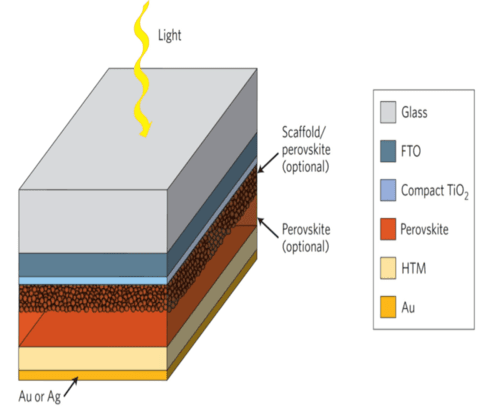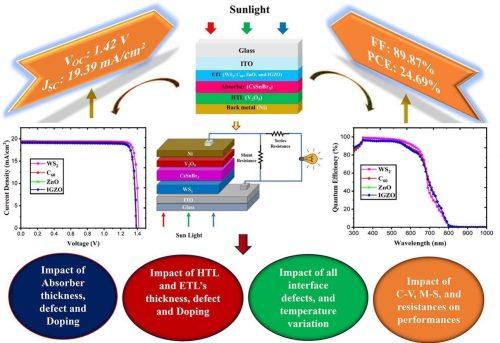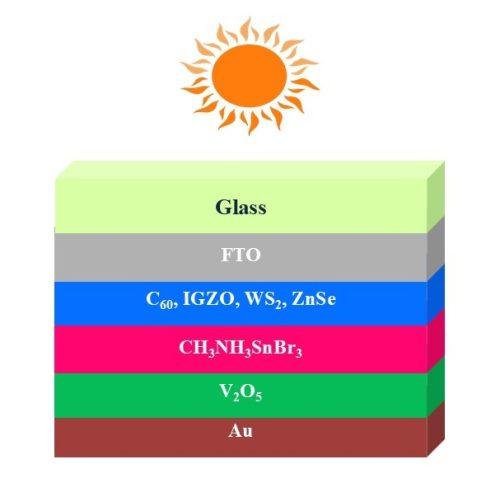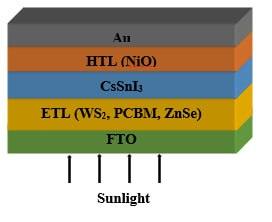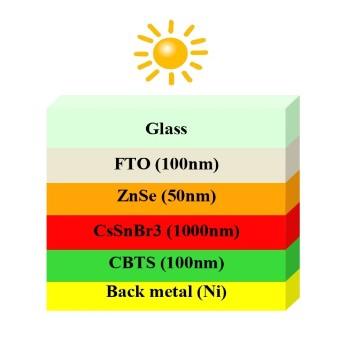Solar Cell
Perovskite solar cells (PSCs) are a next-generation solar technology that has garnered significant attention due to their impressive efficiency and potential for low-cost production. These cells are based on a class of materials known as perovskites, which have a unique crystal structure that allows them to absorb light effectively and convert it into electricity with high efficiency. In recent years, perovskite solar cells have demonstrated rapid advancements, achieving efficiencies comparable to traditional silicon-based solar cells. One of the main advantages of perovskite solar cells is their ability to be fabricated using low-cost, solution-based processes, such as printing and coating, which contrasts with the high-temperature, complex methods required for silicon solar cells. This could potentially lead to significant reductions in production costs, making solar energy more accessible and affordable.
1. Investigating charge transport layer flexibility for boosted performance in Lead-Free CsSnBr3-based perovskite solar cells
Perovskite solar cells (PSCs) have garnered significant interest due to their high-power conversion efficiency (PCE) and potential applications in both organic and inorganic materials. CsSnBr3 has emerged as a promising material for the absorber layer in photovoltaic applications, offering excellent stability, cost-effectiveness, and outstanding efficiency. This study employed SCAPS-1D for the numerical simulation of CsSnBr3-based PSCs. The objective was to fine-tune multiple parameters of the hole transport layer (HTL), absorber layer, and electron transport layer (ETL). The simulations with V2O5 as the HTL were used to study CsSnBr3-based PSCs employing various ETLs (WS2, C60, ZnO, and IGZO). It further investigated how variation in the thickness, defect density, and doping density of the absorber layer, HTL, and ETL will affect the critical device performance parameters, i.e., PCE, fill factor (FF), open circuit voltage (VOC) and short-circuit current density (JSC). The results indicate that the ETL can be modified to enhance the cell’s power conversion efficiency. Indeed, ETL using WS2, C60, ZnO, and IGZO gives rise to 24.69%, 23.99%, 23.79%, and 23.77% PCE values, respectively. Author – Asadul Shimul.
2. Enhancing the Efficiency of (CH₃NH₃)₂CuCl₄-based Perovskite Solar Cells by Selecting a Suitable Electron Transport Layer
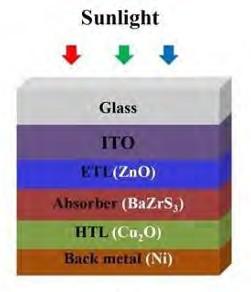
3. Performance Enhancement of Lead-Free CH3NH3SnBr3 Perovskite Solar Cell: Design and Simulation with Different Electron Transport Layers.
CH3NH3SnBr3 is a promising lead-free material that shows potential as a substitute for lead-based material in the development of ecologically benign perovskite solar cells (PSCs) due to its low cost, high efficiency, and excellent thermal stability. This research is intended to enhance the efficiency of CH3NH3SnBr3-based PSCs by employing numerical simulation through the One Dimensional Solar Cell Capacitance Simulator (SCAPS-1D) to optimize the optoelectronic properties of the electron transport layer (ETL), absorber layer, hole transport layer (HTL), and different interface layers. An investigation was conducted to evaluate the influence of different ETLs namely C60, IGZO, WS2, and ZnSe on the performance of CH3NH3SnBr3-based PSCs utilizing V2O5 as the HTL. Moreover, the influence of variations in the thickness, doping density, and defect desity of the absorber layer, ETL, and HTL on key photovoltaic parameters including power conversion efficiency (PCE), short-circuit current density (JSC), open circuit voltage (VOC), and fill factor (FF) was observed. Author – Asadul Shimul.
4. Numerical Investigation of a Novel Lead-Free Perovskite Solar Cell with FTO/ETL/CsSnI₃/NiO architecture for High-Efficiency Photovoltaic Applications

This is an eco-friendly, highly efficient novel perovskite solar cell that addresses energy and environmental challenges. When sunlight strikes the CsSnI3 layer, photons excite electrons from the valence band (VB) to the absorber layer’s conduction band (CB), creating electron-hole pairs. The excited electrons in the conduction band of CsSnI3 are transferred to the lower conduction band of the ETL. As the conduction band of ETL is lower than the absorber conduction band, it enables the movement and transport of electrons in PSCs by creating an enhanced channel with no barrier to electron flow. From ETL, the electrons are collected by the FTO. The remaining holes in the valence band of CsSnI3 are transferred to the NiO (HTL) valence band, which is higher than the perovskite’s valence band, and then transferred to the anode(Au). Many kinds of research are undergoing on CsSnI3-based perovskite due to its low toxicity, and low cost. Further developments are undergoing to make it more sustainable and achieve more efficiency by using different ETL and HTL. Author – Swarna Rani Sarker
5. Enhancing CIGS Solar Cells Efficiency through MoS2 Window Layer

Perovskite solar cells (PSCs) are gaining popularity due to their higher photovoltaic (PV) performance than conventional PV cells. They offer several advantages, including low cost, easy production, adjustable bandgap energy, and remarkable electrical and optical characteristics. We used the SCAPS- 1D modeling program to design and develop a new lead-free perovskite solar cell structure: glass/FTO/ZnSe/CsSnBr 3 /CBTS/Ni. The absorber layer employs the lead-free perovskite material CsSnBr 3 , while other organic and inorganic hole transport layers (HTLs) were investigated to enhance efficiency and reduce expenses. The best HTL were chosen after conducting thorough simulations. The thickness and doping concentrations of the electron transport layer (ETL), HTL, and absorber layers were fine-tuned, and the maximum allowable defect densities were determined. The solar cell structure was optimized to obtain a short circuit current density (Jsc) of 19.14 mA/cm 2 , an open circuit voltage (Voc) of 1.39 V, and a fill factor (FF) of 89.27%. As a result, the power conversion efficiency (PCE) achieved 23.73%. These results suggest that, based on the simulated outcomes of this design, a stable, effective, and affordable perovskite PV cell structure could be used in the future. Author – Atiq Shahriare

